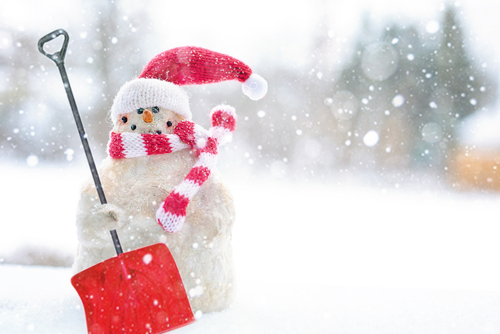Written on: January 9, 2020
 If you live in the northeast, snow is nothing new. The first storm of the winter season has most likely already passed, and we can all be sure there are more to come.
If you live in the northeast, snow is nothing new. The first storm of the winter season has most likely already passed, and we can all be sure there are more to come.
Still, no matter how many times you have shoveled your driveway, there are always ways to improve. Use these tips next storm for a safer, more efficient shoveling experience.
For many of us, shoveling snow is an unpleasant chore, but for others, it’s a downright dangerous activity.
According to the American Heart Association, shoveling snow can put some people at risk of a heart attack. Especially if you’re not a particularly active person throughout the year.
Sudden exertion, like moving dense mounds of snow, can put a strain on the heart, especially as we get older.
If you don’t prepare your body for shoveling correctly, you can easily injure yourself during the tedious task. That makes it critical for you to take a few precautions before cleaning off your driveway.
Before beginning your shoveling for the day, take a few minutes to stretch out your legs, back, arms, and shoulders. Stretching will warm your muscles up to help prevent injury. If you become tired when shoveling, don’t overdo it, take a break to regain your energy.
The longer that snow sits, the heavier and denser it becomes. Try attacking snow in your driveway when it’s fresh. Even if you anticipate snowfall for the entire day and the idea of going in and out of your home to shovel sounds daunting, remind yourself, it’s easier to shovel two inches of fresh snow than six inches of packed snow. By shoveling in shifts, throughout the day, you’ll have lighter shovels, and you’ll be able to conserve your energy.
If you choose to lift snow, as opposed to pushing it, remember to keep good form so you can protect your body from injury:
Know your limits. Don’t fill your shovel with too much snow at once. Overexertion will make you tired quickly, and could make you more prone to injuries.
If you’ve grown up in the snow, the idea of shoveling is just one that comes with the seasons. But, when is the last time you thought about just how much energy you’re actually exerting while performing the task? During the next storm, be sure to take breaks so you can stay hydrated, eat properly, and refuel your electrolytes while shoveling. Remember to refuel after you’re done shoveling as well.
There is always room for improvement when it comes to your shoveling technique. Consider these tricks for shoveling snow more effectively and efficiently.
You will exert less energy, and protect your back if you push snow rather than lifting it. This is an especially important tip if the snow has gotten ahead of you, and it’s dense and compact.
You might also consider using a snow blower for efficiency. If you decide to use a blower, follow the American Academy of Orthopedic Surgeons standards of safety, which recommends:
Make the best use of your time and be as efficient as possible, by avoiding touching the same snow more than once. Shovelers become victims of the ‘two-touch’ method when piling snow into large banks on the perimeter of a driveway. By using this technique, snow will often slide from the top of these tall mounds back down onto your driveway, causing you to remove it again.
To avoid this from happening, evenly disperse where you dump your snow to avoid tall piles.
Nothing is more frustrating than getting your driveway clear all the way to the street, only to have the plow push the snow right back onto the foot of your driveway. If you are shoveling during a snowstorm or immediately after one ends, chances are the snowplows will still be running. Let them plow the street first because there will be an excessive amount of snow at the foot of your driveway.
Save shoveling this area for last to avoid shoveling it multiple times throughout the day.
Check the weather report! If you see snow in the forecast, prepare by adding salt to your driveway for an easier day of shoveling to follow. Salt on your driveway causes ice to melt because the solution of water and dissolved salt has a lower freezing point than pure water. This means you won’t have to hack the shovel against the ice to break it up, making for a strenuous situation. It will also decrease the density of your snow mound.
At Santa Fuel, we take safety in our community very seriously. If shoveling snow is becoming too much of a burden to you, see if a friendly neighbor, family member, or friend can lend a hand. Some communities have Village Networks that allow you to rely on volunteers to help you move snow when it’s too overwhelming for you.